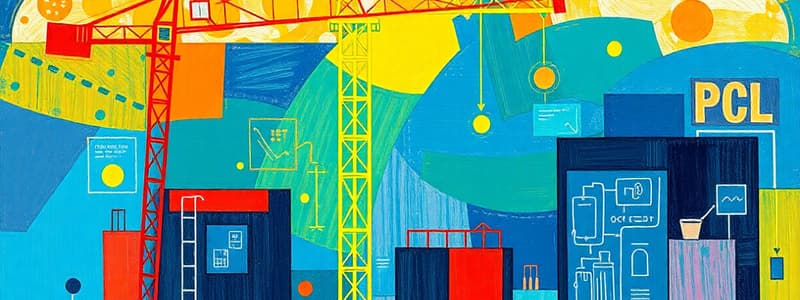Podcast
Questions and Answers
What is the primary purpose of an information system in an organization?
What is the primary purpose of an information system in an organization?
- To store raw data only
- To limit access to company data
- To provide hardware resources
- To convert data into useful information (correct)
Which of the following describes 'business intelligence'?
Which of the following describes 'business intelligence'?
- A technology used for data storage
- Information analyzed from multiple sources for decision making (correct)
- Raw facts about events or objects
- Data that is unrelated to any specific context
Which option correctly defines 'data'?
Which option correctly defines 'data'?
- Information processed to provide insights
- Structured information that aids in decision making
- Raw facts that describe characteristics of events or objects (correct)
- Converted signals that represent facts
Which of the following is NOT a core driver of the information age?
Which of the following is NOT a core driver of the information age?
What is a key benefit of using cloud-based systems for data backup?
What is a key benefit of using cloud-based systems for data backup?
What differentiates information systems from information technology?
What differentiates information systems from information technology?
Which of these is an example of information rather than data?
Which of these is an example of information rather than data?
What type of information do PCL employees access through mobile devices?
What type of information do PCL employees access through mobile devices?
What is the primary responsibility of a Chief Security Officer (CSO)?
What is the primary responsibility of a Chief Security Officer (CSO)?
Which group is primarily responsible for long-range decisions in an organization?
Which group is primarily responsible for long-range decisions in an organization?
What combination of elements does an information system encompass?
What combination of elements does an information system encompass?
Who are knowledge workers in an organization?
Who are knowledge workers in an organization?
What distinguishes MIS from computer literacy?
What distinguishes MIS from computer literacy?
Which level of management is responsible for monitoring daily activities?
Which level of management is responsible for monitoring daily activities?
What aspect does information systems literacy include?
What aspect does information systems literacy include?
What role do data workers play in an organization?
What role do data workers play in an organization?
What is a defining characteristic of a digital firm?
What is a defining characteristic of a digital firm?
Which of the following is NOT a key corporate asset managed in a digital firm?
Which of the following is NOT a key corporate asset managed in a digital firm?
How do digital firms respond to their environments compared to traditional firms?
How do digital firms respond to their environments compared to traditional firms?
Which of the following processes is typically accomplished through digital networks in a digital firm?
Which of the following processes is typically accomplished through digital networks in a digital firm?
What type of information is readily available in a digital firm to support key business decisions?
What type of information is readily available in a digital firm to support key business decisions?
What technology trend has led to the emergence of digital firms?
What technology trend has led to the emergence of digital firms?
Which business process is NOT an example of core processes typically handled digitally in a digital firm?
Which business process is NOT an example of core processes typically handled digitally in a digital firm?
What is one of the benefits of a digital firm's ability to sense and respond rapidly?
What is one of the benefits of a digital firm's ability to sense and respond rapidly?
What are the major business functions performed by organizations?
What are the major business functions performed by organizations?
What do business processes consist of?
What do business processes consist of?
How does information technology assist managers?
How does information technology assist managers?
What is the role of computer hardware in an information system?
What is the role of computer hardware in an information system?
Which of the following best describes the culture of an organization?
Which of the following best describes the culture of an organization?
What component of information technology links hardware and transfers data?
What component of information technology links hardware and transfers data?
Which of the following is NOT a function of managers in organizations according to the discussed dimensions?
Which of the following is NOT a function of managers in organizations according to the discussed dimensions?
Which aspect of information systems does not include formal rules for accomplishing tasks?
Which aspect of information systems does not include formal rules for accomplishing tasks?
Flashcards are hidden until you start studying
Study Notes
PCL Construction
- PCL Construction is a group of independent general contracting construction companies with over 4,400 employees in the United States, Canada, and Australia.
- PCL Construction operates in various sectors including commercial, institutional, multifamily residential, renewable energy, heavy industrial, historical restoration, and civil construction.
- PCL Construction faced challenges such as widespread operations, paper-intensive processes, difficulty in locating documents, and difficulties in keeping project documentation up to date.
- PCL Construction adopted solutions such as mobile devices, touch screen kiosks, Microsoft Azure Cloud, and virtual design and project management to address these challenges.
- Information technology has changed how PCL runs its business.
- PCL saves 80 percent of the cost of backing up its corporate data by using the cloud platform.
Information Systems and its Activities
- Information technology refers to the hardware and software a business uses to achieve its objectives.
- An information system is a set of interrelated components that collect, process, store, and distribute information to support decision making and control in an organization.
Core Drivers of The Information Age
- Data is raw facts that describe the characteristics of an event or object.
- Information is data converted into a meaningful and useful context.
- Business intelligence is information collected from multiple sources that analyzes patterns, trends, and relationships for strategic decision making.
- Knowledge is the process of distilling information to create something new and useful.
- Data, information, business intelligence, and knowledge are all essential components of the information age and drive effective decision making.
The MIS Solution
- Digital firms are those where nearly all significant business relationships are digitally enabled and mediated.
- Key characteristics of digital firms include core business processes accomplished through digital networks, key corporate assets managed through digital means, rapid response to environmental changes, and flexible survival in turbulent times.
MIS Department Roles and Responsibilities
- The Chief Security Officer (CSO) is responsible for ensuring the security of IT systems.
- The Chief Technology Officer (CTO) is responsible for ensuring the throughput, speed, accuracy, availability, and reliability of IT.
Dimensions of Information Systems
- Information systems offer solutions to challenges within a firm and encompass management, organization, and technology elements.
- Information systems literacy encompasses a understanding of the management, organization, and technical dimensions of systems.
- Computer literacy focuses on knowledge of information technology.
- Management information systems (MIS) seeks to achieve broader information systems literacy.
- MIS addresses both behavioral and technical issues related to the development, use, and impact of information systems.
Dimensions of Information Systems: Organizations
- Organizations have a hierarchy of authority and responsibility, including senior management, middle management, operational management, knowledge workers, data workers, and production or service workers.
- Organizations have core business functions, specific tasks performed by businesses, including sales and marketing, manufacturing and production, finance and accounting, and human resources.
- Formal business processes, established rules for accomplishing tasks, guide employee behavior.
- Information systems automate many business processes, such as credit approval and customer billing.
- Organizational culture consists of fundamental assumptions, values, and ways of doing things that have been accepted by most members.
Dimensions of Information Systems: Management
- Managers set organizational strategy for responding to business challenges and problems.
- Managers must act creatively, such as creating new products and services or re-creating their organization.
- Information technology can help managers design and deliver new products and services, and redirect and redesign their organizations.
Dimensions of Information Systems: Information Technology
- Computer hardware is the physical equipment used for input, processing, and output activities in an information system.
- Computer software consists of preprogrammed instructions that control and coordinate computer hardware.
- Networking and telecommunications technology consists of physical devices and software that link hardware and transfer data from one location to another.
Studying That Suits You
Use AI to generate personalized quizzes and flashcards to suit your learning preferences.




